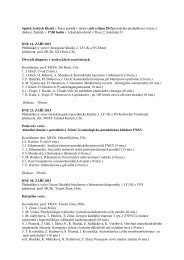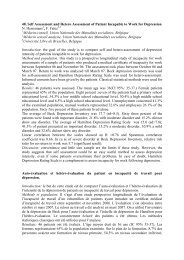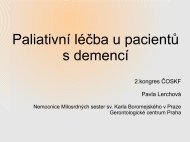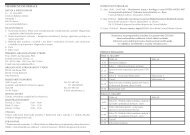ABSTRACTS â ORAL PRESENTATIONS - AMCA, spol. s r.o.
ABSTRACTS â ORAL PRESENTATIONS - AMCA, spol. s r.o.
ABSTRACTS â ORAL PRESENTATIONS - AMCA, spol. s r.o.
You also want an ePaper? Increase the reach of your titles
YUMPU automatically turns print PDFs into web optimized ePapers that Google loves.
Furthermore, they may unravel targets to interfere with in order to affect tumor stromal<br />
interaction and/or inhibit tumor growth. Moreover, counteracting inhibitory effects<br />
may enable to grow tumors and provide novel in vivo models as well as combination of<br />
differentiated tumor associated fibroblasts with tumor cells may produce more relevant<br />
tumor models for evaluation of tumor behavior and responses in vivo.<br />
Acknowledgements<br />
This work was supported by the Slovak Research and Development Agency under the<br />
contract No.APVV-0230-11, VEGA grants 2/0088/11 and 2/0171/13. The experiments on<br />
the IncuCyte ZOOM were enabled with the kind help and the financial support from<br />
the Cancer Research Foundation.<br />
1. Kucerova L, Matuskova M, Hlubinova K, Altanerova V, Altaner C: Tumor cell behaviour<br />
modulation by mesenchymal stromal cells. Mol Cancer 2010, 9:129.<br />
2. Kucerova L, Kovacovicova M, Polak S, Bohac M, Fedeles J, Palencar D, Matuskova M:<br />
Interaction of human adipose tissue-derived mesenchymal stromal cells with breast<br />
cancer cells. Neoplasma 2011, 58:361-370.<br />
3. Kucerova L, Skolekova S: Tumor microenvironment and the role of mesenchymal<br />
stromal cells. Neoplasma 2013, 60:1-10.<br />
59. USE OF NANO-SIZED REALGAR PARTICLES AND SOLUBLE ARSENIC IN TREATMENT<br />
OF CANCER: KNOWLEDGE FROM TRADITIONAL CHINESE MEDICINE<br />
Pastorek M. 1 , Balaz P. 2 , Bujnakova Z. 2 , Jakubikova J. 1,3 , Cholujova D. 1 , Gronesova P. 1 ,<br />
Duraj J. 1 , Hunakova L. 1 , Sedlak J. 1<br />
1<br />
Cancer Research Institute, Slovak Academy of Sciences<br />
2<br />
Institute of Geotechnics, Slovak Academy of Sciences<br />
3<br />
Dana Farber Cancer Institute, Department of Medical Oncology, Boston, USA<br />
Despite significant progress that has been made in field of cancer treatment, it still<br />
remains an incurable disease. The use of natural compounds from traditional chinese<br />
medicine and their application along with western knowledge is among a new emerging<br />
efforts in cancer patient treatment. Xionghuang is a traditional remedy containing realgar<br />
(As 4<br />
S 4<br />
) prepared by special procedure. Because of its very low solubility we have used<br />
high-energy milling to prepare realgar in form of nanoparticles. Therefore the effect of<br />
realgar was compared with ATO (arsenic trioxide) using the panel of melanoma cell lines.<br />
Flow cytometry analysis showed time- and concentration-dependent cytotoxicity<br />
of realgar nanoparticles and ATO solution that was proportional to concentration of<br />
arsenic. Both tested compounds influenced cell cycle distribution with significant<br />
induction of G2/M block. Despite postive and negative regulation of glutathione level<br />
observed within different ranges of arsenic concentration, the use of BSO (inhibitor of<br />
GSH synthesis) increased toxicity of realgar and ATO within whole concentration scale of<br />
arsenic. Combined treatment of realgar or ATO with sulforaphane, the chemopreventive<br />
compound known for modulation of GSH level, achieved synergistic toxic effect.<br />
Analytical Cytometry VII 75








